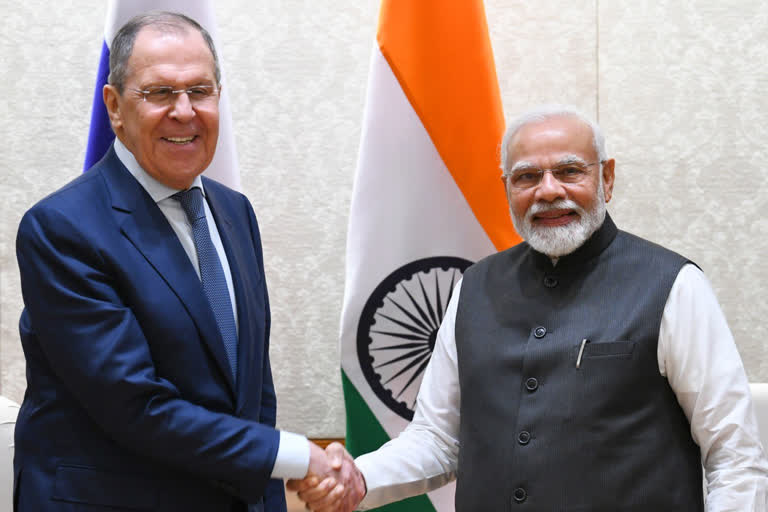New Delhi: After the Russian foray into Ukraine on the dawn of February 24, of late, New Delhi has become the port of call for world powers of note in what may be construed as a high point of ongoing efforts of Indian diplomacy.
The very important visits in just the recent past couple of days include that of Wang Yi, the Chinese foreign minister and state counsellor, Daleep Singh, the US deputy national security adviser, Liz Truss, British foreign secretary, Jens Plötner, the German foreign and security policy advisor, and the ongoing visit as of Saturday, of Russian Foreign Minister Sergey Lavrov—all in relentless pursuit of their respective national goals and the fervent desire to have Indian on their side.
The well-devised Indian position of maintaining anti-war rhetoric on the Ukraine conflict, refusing to categorically condemn the Russian military action and at the same time not cowing down to toe the US-led NATO and western narrative has fetched rich dividends—India is indeed in high demand.
But in the ongoing process of trying to undermine the hegemony of the US dollar in the historical perspective—where the Ukraine conflict is an effect of and just a highlight—India’s position would considerably shift the balance of heft on either the US-led bloc or the Russia-China-led effort that is trying to undo the US domination.
The gold standard—where a fixed quantity of gold was the basis for the international monetary and financial system—led to a number of complications especially after the Second World War. A brainchild of the then US President Franklin Roosevelt, the Bretton Woods norms system was ushered in after a conference—also called the UN Monetary and Financial Conference—of 44 Allied nations in July 1944, decided on a new financial system that would aid economic cooperation and growth.
The central feature was an adjustably pegged foreign exchange market rate system that was pegged to gold. By 1968, the Bretton Woods norms were proving unworkable leading to the system’s dissolution in 1973. All members were free to choose any form of exchange arrangement other than pegging their currency to gold. The era of floating exchange rates had set in.
This was the time for the petrodollar to flourish leading to a greater demand for the US dollar for countries to buy energy items as petrol continued to be bought and sold with US dollars—a currency that began to be coveted by every nation. The petrodollar system emanated from a pact between US President Richard Nixon and Saudi Arabia’s King Faisal bin Abdulaziz Al Saud in 1973 when US bought oil from Saudi Arabia paying for it in dollars in return for US protection and military equipment.
The most traded commodity in the world, petrol, continued to be bought and sold only in dollars resulting in a pre-eminent and dominant position for the US that energized its superpower status. About 80 per cent of all oil transactions across the world are denominated in dollar.
In between there were several attempts to override the petrodollar system that proved to be stillborn not including the aggressive articulation by Libya’s Muammar Gaddafi and Iraq’s Saddam Hussain. Gaddafi died in October 2011 in captivity after his convoy came under an attack by US-led NATO forces while Saddam Hussain was hanged in 2006 after his capture by US forces in 2003.
Nor could the Euro prove to be an alternate system to the petrodollar with the Russian Rouble and the Chinese Yuan meeting the same fate while Venezuala came under stringent US sanctions for having even dared. But the present scenario is far grimmer for the US and may indeed prove to be a watershed moment even as strong signs are emerging of an affinity between Russia, China and Iran. And if India lends its presence, it could be a formidable block that could stand up to the dollar.
The signs are certainly ominous with Russian Foreign Minister Lavrov stating on Friday after his meeting with India’s foreign minister S Jaishankar: “I would recall that many years ago, we started moving in our relations with India, China (and) many other countries from using dollars and euros to more and more use of national currencies. Under the current circumstances, this trend, I believe, will be intensified, which is natural and obvious.”
Significantly, the minister also commented on the Russia-India-China axis being a ‘troika’. “We are close partners with both countries. The three of us participate in a number of international formats... There is our 'troika' - RIC (Russia, India, China).” Clearly, the challenge to the petrodollar—which is at the heart of the US economy—is a formidable one this time around and has profound implications for an alternative financial system.
Also read: Chinese FM Wang Yi holds talks with EAM Jaishankar for delegation-level talks



